目录
- 1.内存配置
- 1.1GetValue
- 2.绑定到实体类
- 3.绑定至对象图
- 4.将数组绑定至类
- 5.在Razor Pages页或MVC视图中访问配置
相关文章
ASP.NET Core2.2 中的Configuration配置一
ASP.NET Core2.2 中的Configuration配置二
1.内存配置
MemoryConfigurationProvider使用内存中集合作为配置键值对。若要激活内存中集合配置,请在ConfigurationBuilder的实例上调用AddInMemoryCollection扩展方法。可以使用IEnumerable<KeyValuePair<String,String>> 初始化配置提供程序。构建主机时调用ConfigureAppConfiguration以指定应用程序的配置:
public class Program
{
public static readonly Dictionary<string, string> _dict =
new Dictionary<string, string>
{
{"MemoryCollectionKey1", "value1"},
{"MemoryCollectionKey2", "value2"}
};
public static void Main(string[] args)
{
CreateWebHostBuilder(args).Build().Run();
}
public static IWebHostBuilder CreateWebHostBuilder(string[] args) =>
WebHost.CreateDefaultBuilder(args)
.ConfigureAppConfiguration((hostingContext, config) =>
{
config.AddInMemoryCollection(_dict);
})
.UseStartup<Startup>();
}
而通过启动应用程序时会看到如下配置信息:
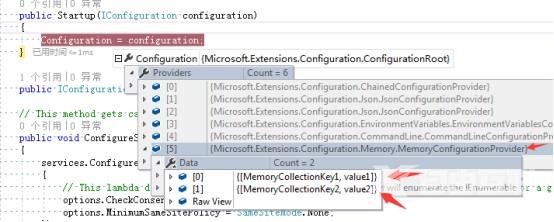
1.1GetValue
ConfigurationBinder.GetValue<T>从具有指定键的配置中提取一个值,并可以将其转换为指定类型。如果未找到该键,则获取配置默认值。如上述示例中,配置两个value1、value2值,现在我们在键MemoryCollectionKey1配置中提取对应字符串值,如果找不到配置键MemoryCollectionKey1,则默认使用value3配置值,示例代码如下:
public Startup(IConfiguration configuration)
{
Configuration = configuration;
var config = Configuration.GetValue<string>("MemoryCollectionKey1", "value3");
}
而通过启动应用程序时会看到如下配置信息:

ConfigurationBinder.GetValue找到定义string类型MemoryCollectionKey1键值并输出。如果我们把获取键名称更改为MemoryCollectionKey3,再来看看获取键值输出结果:

我们会看到当ConfigurationBinder.GetValue找不到定义string类型MemoryCollectionKey3键时,则输出默认值。
2.绑定到实体类
可以使用选项模式将文件配置绑定到相关实体类。配置值作为字符串返回,但调用Bind 可以绑定POCO对象。Bind在Microsoft.Extensions.Configuration.Binder包中,后者在 Microsoft.AspNetCore.App元包中。现在我们在CoreWeb/Models目录下新增一个叫starship.json文件,配置内容如下:
{
"starship": {
"name": "USS Enterprise",
"registry": "NCC-1701",
"class": "Constitution",
"length": 304.8,
"commissioned": false
},
"trademark": "Paramount Pictures Corp. http://www.paramount.com"
}
然后再新增一个对应配置内容的实体模型(/Models/Starship.cs):
public class Starship
{
public string Name { get; set; }
public string Registry { get; set; }
public string Class { get; set; }
public decimal Length { get; set; }
public bool Commissioned { get; set; }
}
构建主机时调用ConfigureAppConfiguration以指定应用程序的配置:
public static void Main(string[] args)
{
CreateWebHostBuilder(args).Build().Run();
}
public static IWebHostBuilder CreateWebHostBuilder(string[] args) =>
WebHost.CreateDefaultBuilder(args)
.ConfigureAppConfiguration((hostingContext, config) =>
{
config.SetBasePath(Directory.GetCurrentDirectory());
config.AddJsonFile(
"starship.json", optional: true, reloadOnChange: true);
})
.UseStartup<Startup>();
示例应用程序调用GetSection方法获取json文件中starship键。通过Bind方法把starship键属性值绑定到Starship类的实例中:
var starship = new Starship();
Configuration.GetSection("starship").Bind(starship);
var _starship = starship;
当应用程序启动时会提供JSON文件配置内容:
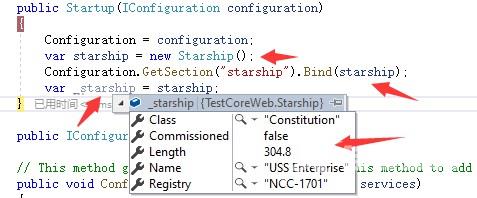
3.绑定至对象图
通过第2小节我们学习到如何绑定配置文件内容映射到实例化实体类属性去,同样,配置文件内容也可以绑定到对象图去。现在我们在CoreWeb/Models目录下新增一个叫tvshow.xml文件,配置内容如下:
<?xml version="1.0" encoding="UTF-8"?>
<configuration>
<tvshow>
<metadata>
<series>Dr. Who</series>
<title>The Sun Makers</title>
<airdate>11/26/1977</airdate>
<episodes>4</episodes>
</metadata>
<actors>
<names>Tom Baker, Louise Jameson, John Leeson</names>
</actors>
<legal>(c)1977 BBC https://www.bbc.co.uk/programmes/b006q2x0</legal>
</tvshow>
</configuration>
然后再新增一个对应配置内容的实体模型(/Models/TvShow.cs),其对象图包含Metadata和 Actors类:
public class TvShow
{
public Metadata Metadata { get; set; }
public Actors Actors { get; set; }
public string Legal { get; set; }
}
public class Metadata
{
public string Series { get; set; }
public string Title { get; set; }
public DateTime AirDate { get; set; }
public int Episodes { get; set; }
}
public class Actors
{
public string Names { get; set; }
}
构建主机时调用ConfigureAppConfiguration以指定应用程序的配置:
config.AddXmlFile("tvshow.xml", optional: true, reloadOnChange: true);
使用Bind方法将配置内容绑定到整个TvShow对象图。将绑定实例分配给用于呈现的属性:
public Startup(IConfiguration configuration)
{
Configuration = configuration;
var tvShow = new TvShow();
Configuration.GetSection("tvshow").Bind(tvShow);
var _tvShow = tvShow;
}
当应用程序启动时会提供XML文件配置内容:
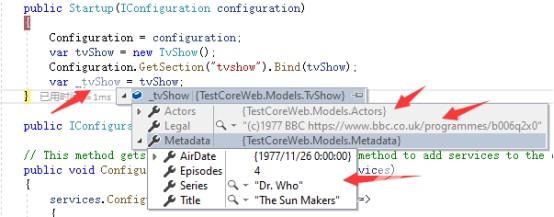
还有一种Bind方法可以将配置内容绑定到整个TvShow对象图:
public Startup(IConfiguration configuration)
{
Configuration = configuration;
var _tvShow = Configuration.GetSection("tvshow").Get<TvShow>();
}
当应用程序启动时会提供XML文件配置内容:
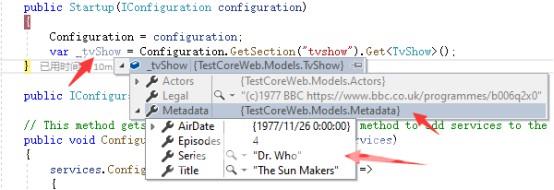
4.将数组绑定至类
Bind方法也支持把配置内容键中的数组绑定到对象类去。公开数字键段(:0:、:1:、… :{n}:)的任何数组格式都能够与POCO类数组进行绑定。使用内存配置提供应用程序在示例中加载这些键和值:
public class Program
{
public static Dictionary<string, string> arrayDict =
new Dictionary<string, string>
{
{"array:entries:0", "value0"},
{"array:entries:1", "value1"},
{"array:entries:2", "value2"},
{"array:entries:4", "value4"},
{"array:entries:5", "value5"}
};
public static void Main(string[] args)
{
CreateWebHostBuilder(args).Build().Run();
}
public static IWebHostBuilder CreateWebHostBuilder(string[] args) =>
WebHost.CreateDefaultBuilder(args)
.ConfigureAppConfiguration((hostingContext, config) =>
{
config.SetBasePath(Directory.GetCurrentDirectory());
config.AddInMemoryCollection(arrayDict);
})
.UseStartup<Startup>();
}
因为配置绑定程序无法绑定null值,所以该数组跳过了索引#3的值。在示例应用程序中,POCO类可用于保存绑定的配置数据:
public class ArrayExample
{
public string[] Entries { get; set; }
}
将配置数据绑定至对象:
public Startup(IConfiguration configuration)
{
Configuration = configuration;
var arrayExample = new ArrayExample();
Configuration.GetSection("array").Bind(arrayExample);
var _arrayExample = arrayExample;
}
还可以使用ConfigurationBinder.Get<T>语法,从而产生更精简的代码:
public Startup(IConfiguration configuration)
{
Configuration = configuration;
var _arrayExample = _config.GetSection("array").Get<ArrayExample>();
}
当应用程序启动时会提供内存配置内容:
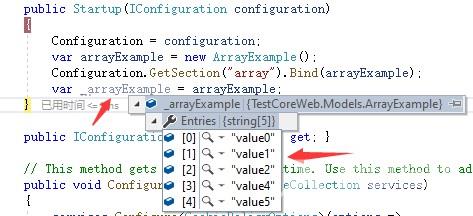
5.在Razor Pages页或MVC视图中访问配置
若要访问RazorPages页或MVC视图中的配置设置,请为Microsoft.Extensions.Configuration命名空间添加using指令(C#参考:using指令)并将IConfiguration注入页面或视图。
在Razor页面页中:
@page
@model IndexModel
@using Microsoft.Extensions.Configuration
@inject IConfiguration Configuration
<!DOCTYPE html>
<html lang="en">
<head>
<title>Index Page</title>
</head>
<body>
<h1>Access configuration in a Razor Pages page</h1>
<p>Configuration value for 'key': @Configuration["key"]</p>
</body>
</html>
在MVC视图中:
@using Microsoft.Extensions.Configuration
@inject IConfiguration Configuration
<!DOCTYPE html>
<html lang="en">
<head>
<title>Index View</title>
</head>
<body>
<h1>Access configuration in an MVC view</h1>
<p>Configuration value for 'key': @Configuration["key"]</p>
</body>
</html>
以上就是本文的全部内容,希望对大家的学习有所帮助,也希望大家多多支持自由互联。
